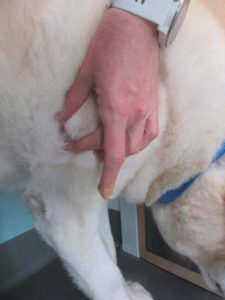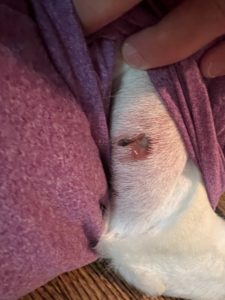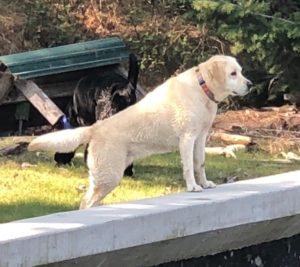
Mast Cell Tumors are one of the most common skin tumors we find in dogs. They are more common in older dogs, but any age dog could develop a mast cell tumor. Their appearance can be quite variable, sometimes just a small raised pink growth; other times they can appear and rapidly grow creating a significant amount of inflammation and irritation to the patient. Classifying Mast Cell Tumors (MCT) can be a little tricky as some can appear and behave in a ‘benign’ fashion, others fall into the category of being an aggressive cancer than can spread internally and become a systemic, or widespread, cancer.
Soza is our Pet of the Month for July 2022. She is a lovely, calm, ‘go with the flow’ Labrador Retriever who was seen at Hawthorne Hills Veterinary Hospital for her routine visit and vaccinations in mid-June. As part of the visit, her owners mentioned a new small little pink growth on Soza’s shoulder. Soza is one of the Labs who has a very dense hair coat and it was difficult to locate the growth under the fur, so it was great that the owners had brought it to our attention. Given that this was a new growth, Dr. Brandi Eskesen felt it was important to sample the tissue to confirm it’s origin.
When collecting tissue cells via Fine Needle Aspirate (FNA) we are trying to capture representative cells to help the pathologist determine the nature of a growth. In many cases the FNA can be diagnostic, which means we know exactly what type of growth is present and whether or not any treatment is needed. Unfortunately, sometimes the FNA sample isn’t clear cut and further diagnostics, or a biopsy, may be needed.
Soza’s little skin growth was confirmed to be a MCT. Since we can’t know from the FNA whether or not this MCT will behave in a cancerous way or not, the best recommendations have been to surgically excise the growth. For a small individual mast cell tumor, surgery can also be considered curative if we can get ‘clean margins’ – meaning that all cancerous cells have been removed. Under anesthesia, the plan is to remove the mass while taking a margin of normal tissue around and deep to the nodule. However, depending on the location of any growth, sometimes we just can’t get wide enough or deep enough margins to get clean margins.
In Soza’s case, at 11 years old, while she was overtly healthy otherwise, she had previously experienced some side effects to anesthesia and we were concerned about her undergoing a surgical procedure.
So, we opted to try a new treatment for mast cell tumors using an injectable drug called Stelfonta. The drug volume is calculated based on the size of the tumor, and the drug is injected directly into the mass. The goal is to kill and destroy all of the cancer cells, thereby achieving tumor free clean margins. There are some specific considerations as to whether or not this treatment can be used for a given mast cell tumor, in particular, the location of the tumor on the dog’s body and the size of the tumor. Large tumors that invade below the skin may not be eligible for this treatment, and some very small tumors can be difficult to inject properly.
However, for Soza, since her growth was involving just the skin and we felt confident that we could inject her tumor, we proceeded forward. There is a precise protocol which we followed exactly. There are several medications that are administered as part of the Stelfonta protocol to reduce the likelihood of severe reactions following treatment. The company does suggest that sedation might be needed for the injection, but Soza didn’t even notice or react. We had her stay in the hospital for about an hour after the injection just to be sure she was fine, then she was sent home for the owners to monitor. Based on the studies, there is a predictable progression of events following the injection.
- Bruising and edema at the site within 15min -24 hrs
- Hemorrhagic necrosis followed by sloughing of the tumor/skin with 3-10 days
- Some seeping of fluid from the site, but seldom any infection
- Granulation of the wound and fully healed 28-42 days post treatment
You can see by the photos, that Soza’s tumor responded exactly as was outlined in the treatment brochures. Wound dressings are not needed, but Soza lives with another Labrador Retriever, and we didn’t want Finn licking the wound site at all, so we had her wear a t-shirt to lightly cover the area.
Soza’s MCT appears to have been successfully treated. Since dogs that develop one MCT can have others, her owners will need to be checking her nooks & crannies on a regular basis for signs of any new skin growths. If she were to develop new mast cell tumors, she could be treated again, depending on the location. For now, she is back to enjoying life with her family and ready to enjoy the rest of the summer.









